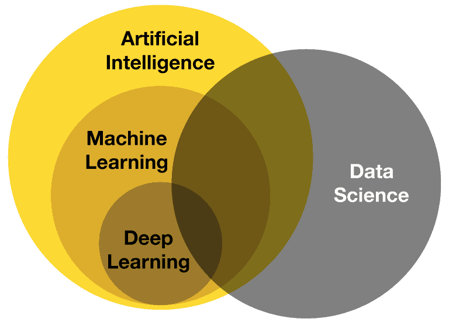Today, the terms Artificial Intelligence (AI), Machine Learning (ML), and Data Science are everywhere and are being used interchangeably. Despite the fact that each of these terms means something different, they’re often lumped together in such a way that it’s hard to tease out what means what. So before we begin a discussion about the role of data science in your machine learning and artificial intelligence projects, we thought we should define what each of these terms means and how the technologies intersect.
First things first. What do each of these terms mean? Here’s how we think about them:
- Artificial Intelligence – AI is the broad concept of developing machines that can simulate human thinking, reasoning and behavior.
- Machine Learning – ML is a subset of AI wherein computer systems learn from the environment and, in turn, use these learnings to improve experiences and processes. All machine learning is AI, but not all AI is machine learning.
- Deep Learning – DL is part of a broader family of machine learning methods based on artificial neural networks. DL uses multiple layers to progressively extract higher-level features from the raw input.
- Data Science – Data Science is the processing, analysis and extraction of relevant assumptions from data. It’s about finding hidden patterns in the data. A Data Scientist makes use of machine learning to predict future events.
Below is a graphic that demonstrates how these disciplines intersect with one another. Here you’ll see that ML is a subset of AI. Additionally, note that Data Science is its own distinct discipline with overlap/application in the fields of AI and ML, but not a subset of either:

Now that we understand what these terms mean and how they work together, let’s look at them in action.
While they may feel ubiquitous, in reality, AI, ML and Data Science have yet to take off in the dramatic ways that industry experts have predicted. According to a NewVantage survey, 77% of businesses report that “business adoption” of big data and AI initiatives continues to represent a significant challenge. And VentureBeatAI reports that as much as 87% of data science projects never even make it into production.
"While investments in analytics are booming, many companies aren’t seeing the ROI they expected. They struggle to move from employing analytics in a few successful use cases to scaling it across the enterprise, embedding it in organizational culture and everyday decision-making."
McKinsey
Our recent infographic argues that one of the chief reasons that AI isn’t being as widely adopted as predicted, and/or isn’t being deployed as successfully as possible is that the data necessary to drive artificial intelligence-based initiatives is either non-existent, insufficient or improperly structured.
Another key factor that’s driving AI’s lower-than-expected success and implementation rates, is that too often, these projects are not supported by the right personnel. Namely, they don’t have the input of a data scientist who can create the machine learning algorithms that deliver high quality predictions and automation.
While there are lots of open source AI frameworks available – think: Google’s TensorFlow, Amazon’s SageMaker, etc. – that may make it seem “easy” to get started building a predictive process, the key personnel required to make sure that the ML models are dialed correctly is often missing. For this work, companies need the help of a trained data scientist who can:
- Identify and apply the right algorithm or develop custom algorithms based on the unique combination of an organization’s objectives and stated goals, and its available data
- Ensure that the business is asking questions of the data that are laser-targeted and precise, so there can be no vague or misleading answers and no misinterpretation that can lead to bad business decisions
- Analyze the data and interpret its meaning and relevance to business objectives to close the loop on the ROI, and better optimize AI projects
- Provide oversight to fine-tune the behavior of training models and help them stay on track
These skills are in such high demand that they’re hard to come by. In fact, a recent survey conducted by Analytics Insight indicates that this year, there will be 3,037,809 new job openings in data science, worldwide.
For these reasons and more, DevIQ has built out its own Data Practice with personnel who are skilled in the science (and the art) of data analysis and machine learning algorithm modeling. These capabilities allow us to offer our clients a full end-to-end ML and data science solution that not only helps them achieve their goals, but also helps overcome some of the challenges listed at the outset of this article.
"We take a very pragmatic approach. The first phase is always focused on proving the value to the business–before spending significant resources on implementation of the technology to support it."
Shawn Davison, CEO of DevIQ
Here’s how our data science approach works:
- Prove Value – First, we process and explore the data and map out the value to the business.
- Implementation – Next, we develop an implementation strategy and an MVP model/method.
- Augmentation – Finally, we refine our strategy and provide enhancement recommendations based on alternative and/or improved data sources.
